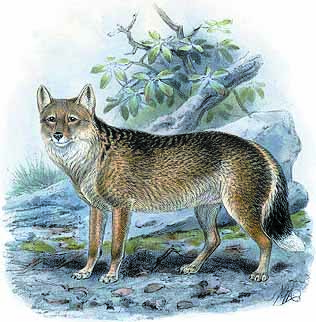UCLA biologists have solved an evolutionary mystery contemplated by Charles Darwin.
In their research paper, the department of ecology and evolutionary biology team disclose the evolutionary relationships of what Darwin described as a peculiar, wolf-like fox, extinct for some 130 years.
Darwin was perplexed by the canid because it was the Falkland Islands’ only native terrestrial mammal. His theory of evolution originated with questions about the Falklands wolf, but neither Darwin nor contemporary scientists could determine the animal’s origins or evolutionary development, said Graham Slater, a postdoctoral scholar and lead author of the paper.
Darwin was also confused by how the animal got to the island, Slater said.
Now DNA from Darwin’s own Falklands wolf specimen and four other museum specimens has led the UCLA team to conclude that the species diverged from a common ancestor some 6.5 million years ago.
The Falklands wolf’s closest living relative is the South American maned wolf, a one-meter tall canid with antelope-like movement.
“It really doesn’t look like anything else that’s around today, and it really doesn’t look that much like the Falkland Islands wolf, so no one has ever suggested this kind of relationship before,” Slater said.
By aligning the animals’ mitochondrial genetic sequences, the team constructed the wolf’s evolutionary tree relative to living South American dogs.
“A lot of people have suggested it was related to coyotes. And some people suggested it would be closely related to these fox-like canids from South America, particularly this one called the Culpeo fox,” Slater said.
As it turns out, these theories were incorrect.
“This is the essential surprise of this paper – that the Falkland Islands wolf is not closely related to dogs or wolves. It’s actually an independent evolution of wolf-like morphologies from South American canids,” said Robert Wayne, a team member and professor of ecology and evolutionary biology.
To have diverged 6.5 million years ago, the origins of the Falklands wolves must not be in South America. The Isthmus of Panama formed a mere 2.5 million years ago, allowing North and Central American mammals, including the wolf’s ancestors, into South America, Wayne said.
After South America, however, the question of how the wolf migrated to the Falklands remains. The land bridge connecting South America to the Falklands was long gone by the time the wolf arrived on the continent, so the species must have traversed the Atlantic some other way, Slater said.
One theory popularized by author Juliet Clutton-Brock suggested Native Americans domesticated and transported the wolf to the islands. Her evidence was the wolf’s white-tipped tail and skull shape, common to animals domesticated by selective breeding.
But by tracing divergence among its five specimens to the islands’ original wolf population, the team found that the wolves arrived in the Falklands 70,000 to 330,000 years ago. Humans did not appear in the Americas until 13,000 years ago, so they could not have transported the species from landmass to landmass, Slater said.
The wolf probably reached the Falklands via iceberg, the research paper stated. Large, drifting ice sheets would have been common during the ice age, and the wolf would have subsisted on seabirds and seals for the journey, Wayne said.
These findings are of particular interest to evolutionary biologists studying the mammalian invasion of South America. Prior to the formation of the Isthmus of Panama, Slater said, there were no mammals on the continent. Now the evolution of the Falkland wolf can be studied in the category of invading North American mammals.
“Being able to add this animal to the dog family tree is going to help us going forward with answering some more questions about the tempo of evolution and how these animals radiated to fill new niches,” Slater said.
The answer to the puzzle comes in time for the 150th anniversary of On the Origin of Species’ publication; 2009 also marks Darwin’s 200th birthday.
